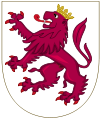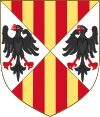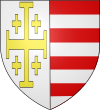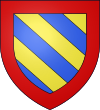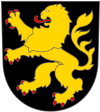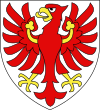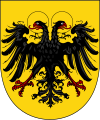Coat of arms of Charles V, Holy Roman Emperor
| Coat of arms of Charles V, Holy Roman Emperor | |
|---|---|
 | |
| Armiger | Charles V |
| Adopted | 1530 |
| Crest | Imperial Crown of Austria |
| Torse | Cross of Burgundy |
| Shield | His maternal inheritance quartering his paternal inheritance |
| Supporters | Imperial Eagle and the Pillars of Hercules |
| Motto | Plus Ultra (Latin areas) Plus Oultre (German and Burgundian areas) |
| Order(s) | Order of the Golden Fleece |
Charles V, Holy Roman Emperor[1] was the heir of four of Europe's leading royal houses. He first inherited the Burgundian Netherlands, which came from his paternal grandmother, Mary of Burgundy. Charles was then the first sole monarch of Spain, inheriting the kingdoms first united by his maternal grandparents, Isabella I of Castile and Ferdinand II of Aragon (the Catholic Monarchs). Finally, on the death of his paternal grandfather, Maximilian I, Holy Roman Emperor, he inherited the Habsburg lands in Austria. His coat of arms, representing much of the land he inherited, is blazoned as follows:
Quarterly: I and IV grand-quarterly i and iv great-grand-quarterly 1 and 4 gules a three towered castle Or masoned sable and ajouré azure (for Castile), 2 and 3 argent a lion rampant purpure crowned Or langued and armed gules (for Leon), ii per pale, dexter per fess, in chief Or four pallets gules (for Aragon), in base gules a cross, saltire, and orle of chains linked together Or and a centre point vert (for Navarre), sinister party per pale argent a cross potent and four crosslets Or impaling barry of eight gules and argent (for Naples), iii per pale, dexter per fess, in chief Or four pallets gules (for Aragon), in base gules a cross, saltire, and orle of chains linked together Or and a centre point vert (for Navarre), sinister per saltire, 1 and 4 Or four pallets gules, 2 and 3 argent an eagle displayed sable (for Sicily); II and III grand-quarterly, i gules a fess argent (for Austria), ii azure semy-de-lis Or a bordure compony argent and gules (for new Burgundy), iii bendy of six Or and azure a bordure gules (for old Burgundy), iv sable a lion rampant Or langued and armed gules (for Brabant), overall at the fess point of the quarter an inescutcheon Or a lion rampant sable armed and langued gules (for Flanders) impaling argent an eagle displayed gules, armed, beaked, and langued Or (for Tyrol); enté en point argent a pomegranate proper seeded gules, supported, sculpted and slipped vert (for Granada). Supporters: A bicephalous eagle displayed sable imperially crowned proper in front of a saltire ragulée gules, the whole between two columns argent issuing from the sea proper in base, the one to dexter crowned imperially proper, the one to sinister crowned with the Royal Crown of Spain proper. The motto, PLVS VLTRA or PLVS OVLTRE, wraps around the columns.
Personal arms



The first and fourth quarters represents holdings derived from the Spanish crowns: that is, the quartered arms of Castile and Leon themselves quartered with the quartered arms of Aragon and Sicily. After 1520 the Aragon/Sicily quartering also incorporated the arms of Jerusalem, Naples, and Navarre.
The second and third quarters represents holdings derived from Charles's Austrian and Burgundian inheritance: these quarters shows further quartering of Austria, Duchy of Burgundy, County of Burgundy, and the Duchy of Brabant, with the escutcheon in the middle showing Flanders on the left and Tyrol on the right.
The Granada pomegranate is represented at the bottom between the two.
Features
| |||||||||||||||||||||||||||||||||||||||||||||||||||||||||||||||||||||||||||||||||||||||||||||||||||||||||
The Burgundian Inheritance and the Order of the Golden Fleece
In 1477, the territory of the Duchy of Burgundy had been conquered and annexed by France. In the same year, Mary "the Rich", the last Burgundian duke's only child, had married Charles' grandfather Maximilian, giving the Habsburgs control of the remainder of the Burgundian Inheritance: although the territory of the Duchy of Burgundy itself remained in the hands of France, the Habsburgs remained in control of the title of Duke of Burgundy and the other parts of the Burgundian inheritance, notably the Low Countries and the Free County of Burgundy in the Holy Roman Empire. They often used the term Burgundy to refer to it until the late 18th century, when the Austrian Netherlands were lost to the French Republic. Although Charles V had inherited the grand mastership of numerous orders, the only order which he habitually wore and awarded was that of the Burgundian Order of the Golden Fleece.
Gallery
 |
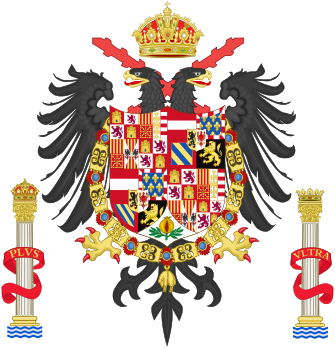 |
| Coat of Arms of Charles when he was Duke of Burgundy and King of Navarre, Castile and Aragon (Version with motto and supporters) | Greater Coat of Arms (common use) 1530-1556 |
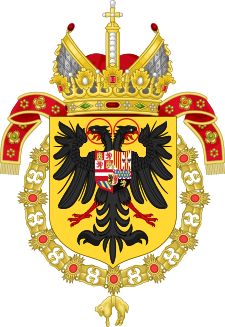 |
 |
| Or shield version | Variant used as Monarch of Naples |
References
- Template:Es icon Gavira Ignacio, Origins and history of the Spanish coat of arms.
- ^ known as Charles I in Spain and Austria, Charles II in Burgundy and Sicily, Charles III in Flanders, Charles IV in Naples
- ^ Template:Es icon Kingdom of Naples arms in the heraldry of Ferdinand II of Aragon as King of Naples, De Francisco Olmos, José María, La moneda napolitana de Fernando el Católico, documento porpagandístico de la unidad de las coronas; . Madrid (2001), p.156.


